Without AI, the Economy Is Toast
![]() Without AI, the Economy Is Toast
Without AI, the Economy Is Toast
 Two leading economists, working independently, have reached the same conclusion: AI spending is the only thing propping up the U.S. economy in 2025.
Two leading economists, working independently, have reached the same conclusion: AI spending is the only thing propping up the U.S. economy in 2025.
“AI has kept the economy out of a recession.” declares James Egelhof, chief U.S. economist with the French banking giant BNP Paribas.
All the money corporate America is pouring into data centers and high-end chips? “The AI boom has convinced the broader business community that a robust expansion and productivity surge lies just over the horizon,” Egelhof told a roundtable of reporters this week.
 Separately, Harvard economist Jason Furman says that without billions of corporate dollars pouring into data centers, U.S. GDP would have grown a measly 0.1% annualized during the first half of 2025 — and not the 1.6% reported by the Commerce Department.
Separately, Harvard economist Jason Furman says that without billions of corporate dollars pouring into data centers, U.S. GDP would have grown a measly 0.1% annualized during the first half of 2025 — and not the 1.6% reported by the Commerce Department.
Here’s how Furman arrives at that figure.
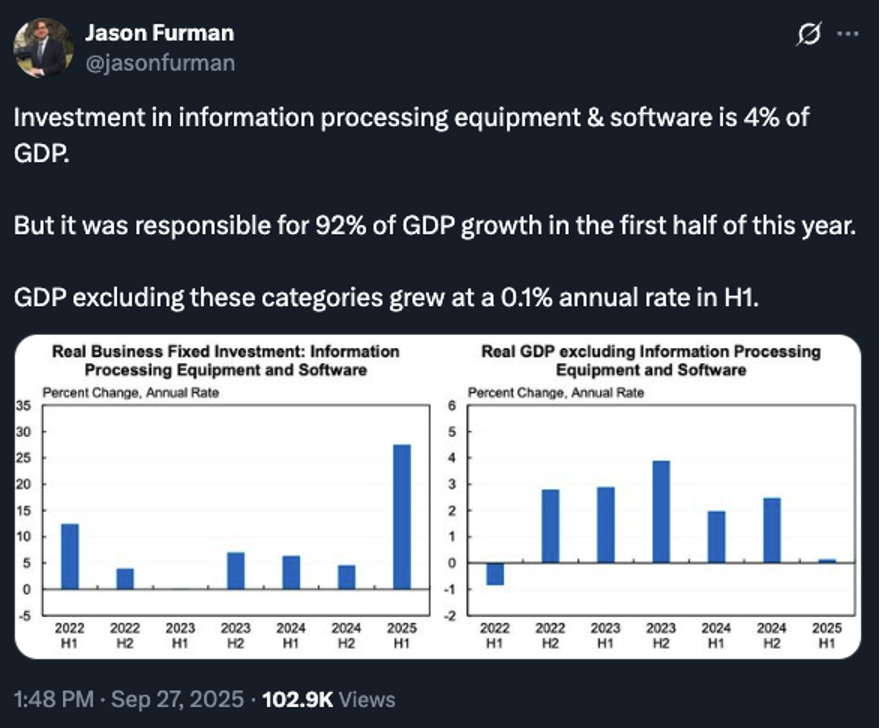
Furman is an Establishment hack — he ran the White House Council of Economic Advisers during Barack Obama’s second term — but he’s probably onto something here.
Consider the following figures:
- According to Goldman Sachs, AI “hyperscalers” like Amazon, Microsoft and Google now account for more than a quarter of all capital spending among S&P 500 companies — growing at a blistering 75% annual pace
- According to Renaissance Macro, the dollar value contributed to GDP growth by the buildout of datacenters now exceeds that of consumer spending.
As Fortune points out, “That’s remarkable considering consumer spending is two-thirds of GDP.”
Or maybe it’s not so remarkable in light of what Emily spotlighted in yesterday’s edition: Auto loan and credit card delinquencies are back to levels seen during and after the 2008 financial crisis. Below the top 10% of income earners — folks who’ve also booked big AI gains in their portfolios — the mighty American consumer is on his heels. (Maybe you’ve noticed that among your friends and neighbors? Or your adult children?)
As Eglehof suggested a moment ago, there’s nothing out there to arrest this trend for the moment — especially now that the Federal Reserve has embarked on a new interest rate-cutting cycle.
 How to profit from the next round of AI spending? Well, the 800-pound gorilla of AI companies, Nvidia, is hosting its annual GTC event next week in Washington, D.C.
How to profit from the next round of AI spending? Well, the 800-pound gorilla of AI companies, Nvidia, is hosting its annual GTC event next week in Washington, D.C.
“It’s where developers, industry leaders and innovators come together to discuss all of the latest discoveries in the artificial intelligence industry,” says Paradigm’s AI authority James Altucher. “And it’s where Nvidia CEO Jensen Huang tends to make the company’s biggest announcements.”
James expects a major announcement next Tuesday at noon EDT. And based on his own proprietary AI algorithm, he expects that announcement to unleash a profit opportunity similar to those in the past that have generated peak gains of 2,350%... 5,133%... and even 7,100% in only six days.
Subscribers to Altucher’s True Alpha already know what to do in advance of Huang’s presentation. If you’re not among them, you owe it to yourself to click here and check out what James has to say right away.
![]() Inflation, Social Security, Record Highs
Inflation, Social Security, Record Highs
 The big market story today is the release of the September inflation numbers, “partial government shutdown” notwithstanding.
The big market story today is the release of the September inflation numbers, “partial government shutdown” notwithstanding.
The bad news — for Main Street, anyway — is that the official inflation rate ticked up from 2.9% to 3% — the highest since January.
The good news — for Wall Street, certainly — is that the number clocked in lower than expected. Lower-than-expected inflation likely means the Federal Reserve will continue cutting short-term interest rates at its next meeting five days from now. And probably again at the meeting after that in mid-December.
Today’s release of the consumer price index was nine days late. Already the White House is warning that as long as the shutdown continues, there won’t be an October inflation report next month.
As we’ve pointed out for a couple of weeks now, the only reason the Bureau of Labor Statistics cobbled together the September report is that the Social Security Administration needs those numbers to set next year’s cost-of-living adjustment for retirees.
 And with today’s release, the Social Security COLA for 2026 will be 2.8%.
And with today’s release, the Social Security COLA for 2026 will be 2.8%.
For the average recipient that translates to a $56-a-month jump to $2,064. As we say every year, don’t spend it all in one place.
Worse, that jump will be offset for many seniors by rising premiums for Medicare Part B. The 2026 increase is still in flux — but over the summer the Medicare program’s trustees estimated the standard premium would jump from $185 to $206.50.
Meanwhile, if you’re still in the workforce, the threshold at which Social Security taxes are no longer collected on your income rises from $176,100 to $184,500 — a 4.8% jump.
 As hinted at above, the market reaction to the lower-than-expected inflation numbers is euphoric.
As hinted at above, the market reaction to the lower-than-expected inflation numbers is euphoric.
At last check the S&P 500 has sailed nearly 1% higher to a record 6,800. The gains in the Dow and the Nasdaq are even more impressive.
For once this week, there’s no meaningful action in the precious metals: Gold is nearly flat from yesterday at $4,126, while silver is down slightly to $48.69. The mining industry’s big dog, Newmont, is down 4% despite reporting gangbuster quarterly numbers after the close yesterday… and the action in NEM is dragging down the HUI index of mining stocks nearly 1%.
The crypto market is little moved today despite news that JPMorgan will allow its institutional clients to use Bitcoin and Ether as collateral for loans by the end of this year. Bitcoin sits a hair over $110,000 while Ethereum is just over $3,900.
Crude continues to bounce off five-month lows, a barrel of West Texas Intermediate set to end the week over $62 — up substantially from less than $57 on Monday.
![]() “A Trillion Here, a Trillion There…”
“A Trillion Here, a Trillion There…”
 For the record…
For the record…
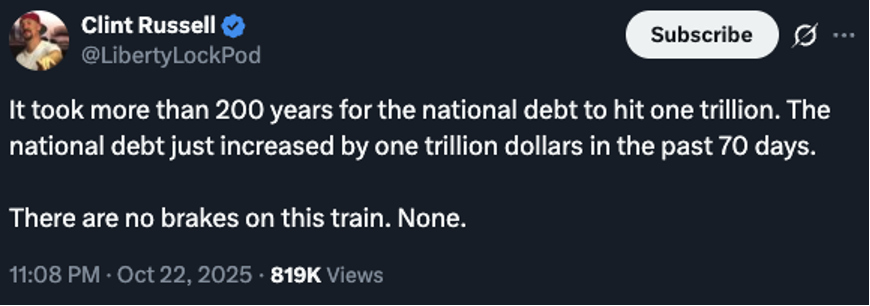
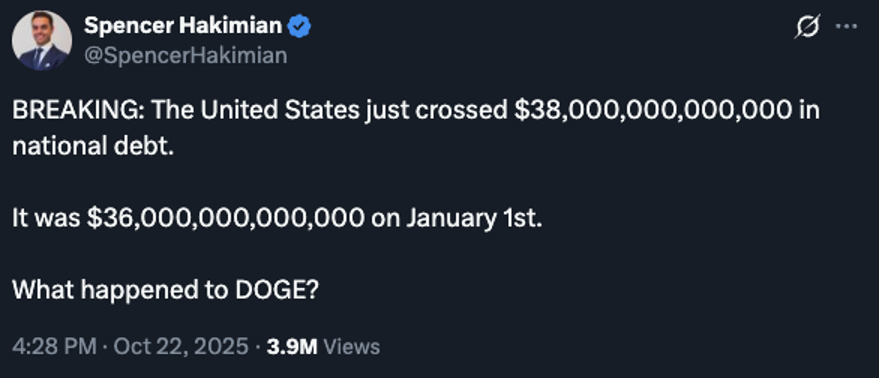
The national debt hit $37 trillion in August. It hit $38 trillion this week. That’s the fastest trillion-dollar accumulation of debt outside the pandemic.
And people wonder why the inflation rate keeps inching higher this year.
A few days ago, the Treasury issued Uncle Sam’s final income-and-outgo numbers for fiscal year 2025 — which ended Sept. 30. Here’s how they compare with the previous year…
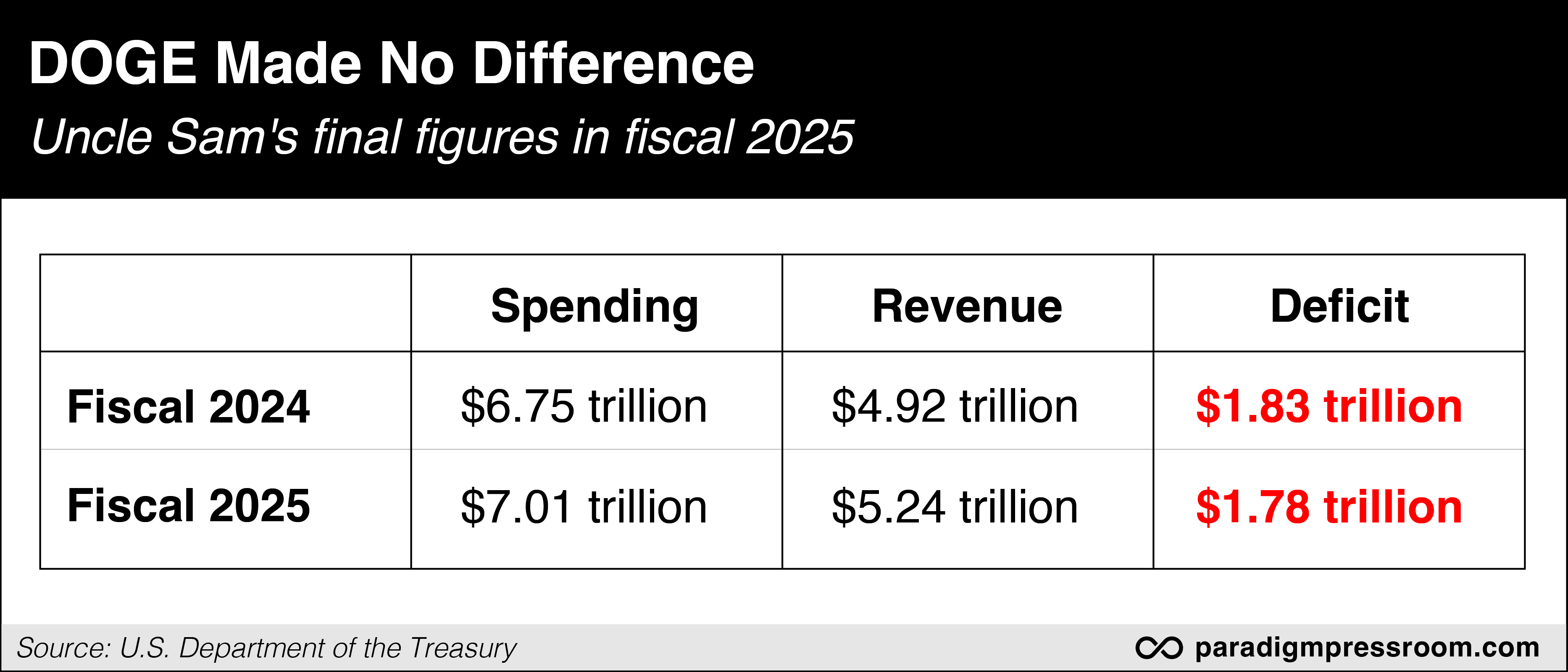
Yes, the annual budget deficit shrank by 2.8% compared with a year earlier — largely thanks to tariff revenue.
But spending grew 3.9% despite the much-ballyhooed efforts of DOGE. Zeroing in on the eight full months of the Trump administration, spending did fall by a microscopic amount — but it would have risen substantially absent some accounting gimmickry with the student loan program.
And get this: Net interest on the debt in fiscal 2025 totaled $971 billion.
As gold expert Don Durrett tweeted this week, “We are borrowing $2T annually to pay $1T in interest. Do the math. It doesn’t work. The clock is ticking.”
Sure is. The annual budget deficit works out to 5.9% of GDP. It’s a slight improvement from the previous year’s 6.4% — but it’s still unprecedented for an era when there’s no world war, no global financial crisis and no pandemic. At this rate, Treasury Secretary Scott Bessent’s goal of reducing the deficit to 3% of GDP by the end of 2028 looks like a pipe dream.
➢ Reminder: Under the “One Big Beautiful Bill Act,” the debt ceiling kicks in again once the national debt reaches $41.1 trillion. We’re only $3.1 trillion away now. There will be another debt-ceiling drama in Washington before the end of Trump’s term.
![]() Inspired Advertising
Inspired Advertising
 On the theory that there’s no such thing as bad publicity…
On the theory that there’s no such thing as bad publicity…

That’s an Instagram post by the German firm Böcker — making the most of the fact that one of its lifts was used for the brazen break-in at the Louvre in Paris last weekend. In only eight minutes, the thieves made off with $102 million in jewelry.
“When you’re in a hurry, the Böcker Agilo carries your heavy treasures,” it says.
Böcker’s managing director Alexander Böcker tells the AFP newswire that he recognized his company’s machine from the news coverage. Given that no one was hurt, he figured it was “an opportunity for us to use the most famous and most visited museum in the world to get a little attention for our company."
And it seems the reaction is overwhelmingly favorable. “Your messaging takes the crown,” says one commenter.
As Böcker tells Reuters, “We have even had feedback from abroad saying, ‘Hey, you Germans do have a sense of humor after all.’”
![]() Parting Shot(s)
Parting Shot(s)
 As long as we have the Louvre on the brain, let’s wrap it up with some quality memeage…
As long as we have the Louvre on the brain, let’s wrap it up with some quality memeage…
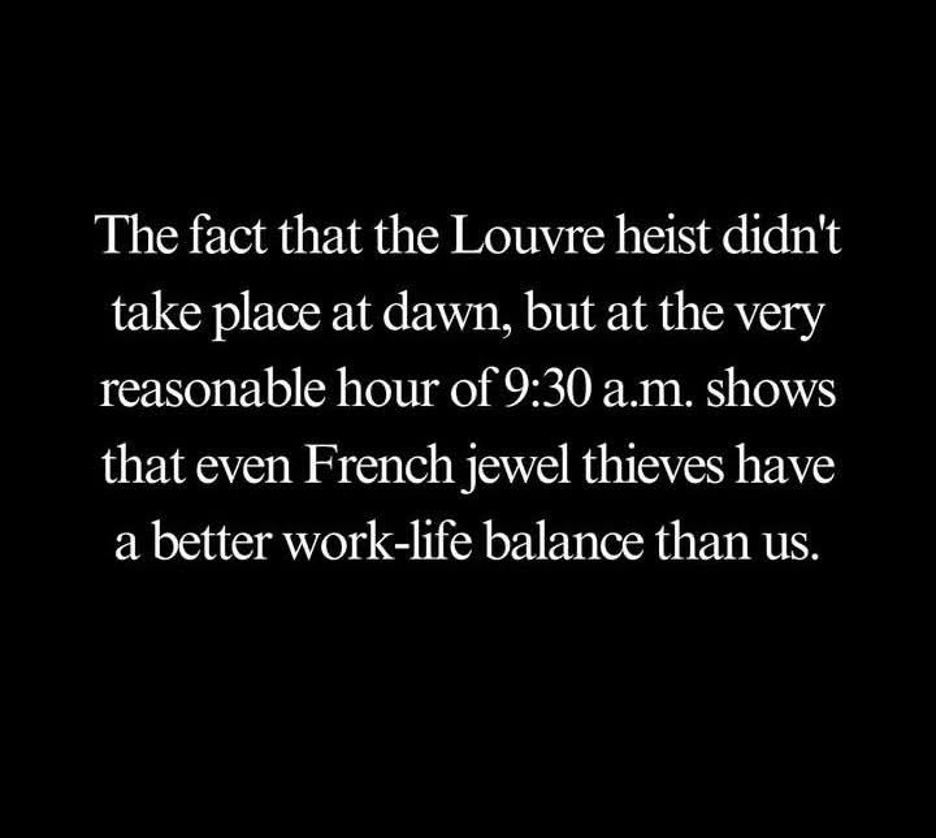

Have a good weekend,

Dave Gonigam
Managing editor, Paradigm Pressroom's 5 Bullets










